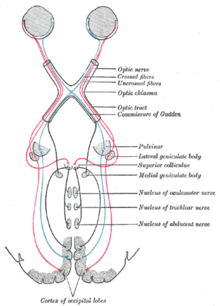Parinaud's syndrome
This article needs additional citations for verification. (February 2015) |
| Parinaud's syndrome | |
|---|---|
| Other names | Dorsal midbrain syndrome, vertical gaze palsy, upward gaze palzy, sunset sign,[1] setting-sun sign,[2] sun-setting sign,[3] sunsetting sign,[4] sunset eye sign,[5] setting-sun phenomenon[5] |
 | |
| Specialty | Neurology |
Parinaud's syndrome is a constellation of neurological signs indicating injury to the dorsal midbrain. More specifically, compression of the vertical gaze center at the rostral interstitial nucleus of medial longitudinal fasciculus (riMLF).
It is a group of abnormalities of
Signs and symptoms
Parinaud's syndrome is a cluster of abnormalities of eye movement and pupil dysfunction, characterized by:
- Paralysis of upwards gaze: Downward gaze is usually preserved. This vertical palsy is doll's head maneuver should elevate the eyes, but eventually all upward gaze mechanisms fail. In the extreme form, conjugate down gaze in the primary position, or the "setting-sun sign" is observed. Neurosurgeons see this sign most commonly in patients with hydrocephalus. [8]
- Pseudo-Argyll Robertson pupils: Accommodative paresis ensues, and pupils become mid-dilated and show light-near dissociation.
- Convergence-retraction nystagmus: Attempts at upward gaze often produce this phenomenon. On fast up-gaze, the eyes pull in and the globes retract. The easiest way to bring out this reaction is to ask the patient to follow down-going stripes on an optokinetic drum.[9]
- Eyelid retraction (Collier's sign)
It is also commonly associated with bilateral
Causes

Parinaud's syndrome results from injury, either direct or compressive, to the dorsal
Classically, it has been associated with three major groups:
- Young patients with brain tumors in the pineal gland or midbrain, causing hydrocephalus
- Women in their 20s-30s with multiple sclerosis
- Older patients following stroke of the upper brainstem
However, any other compression, ischemia or damage to this region can produce these phenomena: hydrocephalus, midbrain hemorrhage, cerebral arteriovenous malformation, trauma and brainstem toxoplasmosis infection. Neoplasms and giant aneurysms of the posterior fossa have also been associated with the midbrain syndrome.
Vertical supranuclear ophthalmoplegia has also been associated with metabolic disorders, such as
overdose.Diagnosis
Diagnosis can be made via combination of physical exam, particularly deficits of the relevant cranial nerves. Confirmation can be made via imaging, such as CT scan or MRI.
Treatment
Treatment is primarily directed towards etiology of the dorsal midbrain syndrome. A thorough workup, including neuroimaging is essential to rule out anatomic lesions or other causes of this syndrome. Visually significant upgaze palsy can be relieved with bilateral inferior rectus recessions. Retraction nystagmus and convergence movement are usually improved with this procedure as well.
Prognosis
The eye findings of Parinaud's syndrome generally improve slowly over months, especially with resolution of the causative factor; continued resolution after the first 3–6 months of onset is uncommon. However, rapid resolution after normalization of intracranial pressure following placement of a
References
- ISBN 978-1-4020-0042-3.
- .
- ISBN 978-1-61705-019-0.)
{{cite book}}: CS1 maint: multiple names: authors list (link - ISBN 978-1-138-03131-9.
- ^ a b Gaillard, Frank. "Sunset eye sign | Radiology Reference Article | Radiopaedia.org". Radiopaedia. Retrieved 2020-01-05.
- Who Named It?
- ^ H. Parinaud. Paralysie des mouvements associés des yeux. Archives de neurologie, Paris, 1883, 5: 145-172.
- ^ Neuro-Ophthalmic Examination
- ^ "Convergence-retraction nystagmus". www.aao.org. Archived from the original on 14 September 2016. Retrieved 17 March 2020.
Further reading
- Aguilar-Rebolledo F, Zárate-Moysén A, Quintana-Roldán G (1998). "Parinaud's syndrome in children". Rev. Invest. Clin. (in Spanish). 50 (3): 217–20. PMID 9763886.
- Waga S, Okada M, Yamamoto Y (1979). "Reversibility of Parinaud syndrome in thalamic hemorrhage". Neurology. 29 (3): 407–9. S2CID 42247406.
